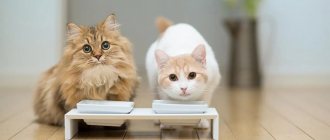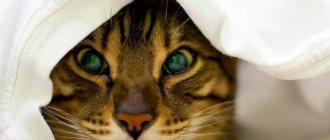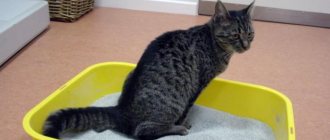How to recognize the problem
When a cat lives in an apartment, reduced frequency of urination is much easier to notice. If your pet is accustomed to go to the toilet outside, it is not always possible to immediately detect the problem. It is worth paying attention to the following signs:
- Restless behavior of the animal: the cat moans, continuously meows and screams
- Sits in the tray for a long time
- Walks around the tray, rubs against it, does not dare to enter
- Blood and pus in the urine
- Bloated and painful belly
- Urine comes out in small quantities. Often these are several small puddles around the tray or in other atypical places.
All this is a reason to be wary and show the animal to a veterinarian. It is not necessary to have all the listed signs; sometimes only some of them may appear.
The main signs of the disease
A cat with such ailments begins to fuss, behave very strangely, and meow. In addition, he will constantly spin around the tray, and when going to the toilet, the pet will press against the edge of the box to help the bladder empty. If a cat has problems urinating normally , it will experience a burning sensation and pain.
However, only a specialist can find out what caused the painful bowel movement. There is an opinion that cats sterilized in childhood are the most susceptible to urolithiasis. Moreover, if the pet still has kidney problems , then he may have no urge to urinate at all. In some situations, it is difficult even for veterinarians to determine the early symptoms of the formation of stones or animal sand in the kidneys.
Causes
Only a qualified veterinarian can determine the true cause of this condition. Here are the most common ones:
- Kidney and bladder stones as a result of insufficient fluid intake
- Unbalanced diet, abundance of raw meat and fish, salty foods in the diet
- Overweight animal
- Hereditary background
- Features of physiology. Sometimes kittens are born with disturbances in the urinary system, most often it is congenital obstruction of the urinary tract
- Experienced stress. For example, a change of place of residence, a new owner, meeting other animals, traveling by car or public transport, etc.
Why does a cat pee a little?
A cat should pee, if it is already a year old, about 2 times a day. If urination does not occur for several days or a very small amount of urine is found in the tray, this indicates a malfunction in the body.
This phenomenon can be caused by the following factors:
- Kidney diseases of congenital or acquired type.
- Urolithiasis (the most common reason why a cat doesn’t pee a lot).
- Inflammatory processes in the urethra or bladder. They can be caused by hypothermia or infection.
- Weakening of the bladder walls (atony). The reason for this may be an injury, surgery, illness, or age-related changes in the cat’s body.
- Anuria. This condition is characterized by the absence of urine and poses a threat to the animal's life.
- Spinal cord damage due to spinal injuries.
- Benign or malignant tumors.
Only a veterinarian can determine the reason why a cat pees little.
Should I worry?
Of course, you need to be careful about your cat’s health, but you shouldn’t panic. Before sounding the alarm, you should make changes to your cat's diet, as this is often the reason. However, if the animal does not urinate for more than a day, you should immediately contact a veterinarian. This condition can have consequences including bladder rupture and death. But before you paint such a picture, you need to do the following regarding your cat’s nutrition:
- Make sure that the animal has access to fresh water and offer it to drink.
- Eliminate milk.
- Exclude fish in any form. This is due to the high phosphorus content, which is deposited in the form of stones in the bladder.
- Do not feed your cat pork. This meat is too fatty and thickens the urine, making it difficult to drain.
- Do not give your cat raw meat.
- Eliminate salty foods.
- If possible, add special food for cats with genitourinary problems to the diet.
- Food should be rich in vitamin A, B6 and glutamic acid.
How to avoid diseases of the genitourinary system?
It is necessary to understand that once you have received such an illness, you will not be able to get rid of it completely. Only preventive measures and regular veterinary examinations will help your cat lead a comfortable lifestyle. To prevent difficulty urinating, you need to follow a few tips:
- Vaccinate your cat on time to reduce the risk of various diseases. Thanks to which fewer microorganisms will penetrate his body.
- The animal must not be allowed to become hypothermic. Do not allow your pet to lie on concrete or cold floors.
- You should give your cat something to drink as often as possible, since drinking large amounts of liquid flushes out its bladder. In this case, the water must be clean and fresh.
- In order to prevent recurrence of inflammation of the genitourinary organs, you need to properly formulate your diet. Completely prohibited products should be excluded from it.
- You need to play with the animal more often. In addition, the cat should run at least 30 minutes a day. Movement will help prevent the occurrence of many diseases.
And remember that giving medications and treating ailments that have led to difficulty urinating in your beloved pet is putting his health and even life in danger . If such problems arise, you should seek help from specialists as quickly as possible. In addition, do not forget to vaccinate your cat.
Treatment
The condition when a cat does not go to the toilet for a long time is dangerous due to the accumulation of pathogenic bacteria in the bladder and the development of inflammatory processes. It is advisable that during the period of an acute condition the animal is in the hospital under the supervision of doctors for several days.
In this case, antibacterial therapy is used; antibiotics, antispasmodics and analgesics can be prescribed. In some cases, a catheter must be inserted to drain urine. This procedure is performed both under general anesthesia and without. When carrying out such a mini-operation, you should pay special attention to the experience and qualifications of the veterinarian, since there are often cases of piercing the bladder, which ultimately leads to the death of the cat.
Acute urinary retention in a cat
This is a very risky phenomenon for the pet's life. He is characterized by the inability to go to the toilet for more than a day. Most often, this problem occurs in males from six months to 10 years of age.
Due to the special structure of the cat's urethra and the high-density mole, the urethra can become clogged with salt crystals, sand and even mucus. Moreover, castration cannot influence the development of such a pathology.
Sources of the problem
Most often, acute urinary retention occurs with urolithiasis and idiopathic cystitis.
Normal urine test results in cats allow for some salt crystals. Moreover, this does not lead to urethral blockage in every pet. As a result, the main factor in the formation of problems with urination is the presence of cystitis.
Symptoms
Usually, owners complain about the pet’s futile attempts to go to the toilet in a small way (the animal often goes into the litter box, stays there for a long time, often meows and tries to lick itself in the urethral area).
When urine is not excreted for more than a day, vomiting, lethargy, and decreased appetite may occur.
How to diagnose
The disease is diagnosed based on anamnestic data (owner complaints), examination of the pet (full and very painful bladder when palpated) and ultrasound results.
Treatment options
Initially, it is necessary to remove fluid from the bladder. To do this, cystocentesis is used (a bladder is pierced through the peritoneum) or urethral catheterization is performed.
If the cat could not go to the toilet for more than a day, the possibility of developing acute kidney failure increases.
To diagnose such a complication, a blood test is prescribed.
When the patency of the urinary canal is restored, antispasmodics, painkillers and antibiotics are prescribed. If acute renal failure does occur, infusion therapy is prescribed.
After laboratory diagnostics of urine, the pet’s diet is determined and, if necessary, additional medications are prescribed to help eliminate the inflammatory process and dissolve salts.
Not every case of urinary dysfunction is amenable to therapeutic treatment. Sometimes surgical intervention is required - urethrostomy. This method is used if there are stones in the urethra, or adhesions have formed on the walls of the urethra after the insertion of a catheter.
It should be remembered that urinary retention for at least 36 hours can lead to the death of your pet.
Self-diagnosing the problem and helping your pet
If you suspect a cat has a urinary disorder, first aid is required. When a pet cannot pee, and there is no possibility of visiting a veterinarian, you need to examine the animal yourself to determine the degree of filling of the bladder.
To do this, the cat is placed on its paws and clasped with its arms. Then the bladder is carefully palpated perpendicular to the ovaries.
If the inflammation is severe, the pet will not allow this. In this case, you need to quickly contact a veterinary hospital.
When the bubble has been successfully examined, you need to evaluate its size and pay attention to its density. Normally, the organ is no larger than a nut and is soft to the touch. If it is large and compacted, and there is a specific odor, the cat should be taken to the veterinarian immediately. To alleviate the animal's condition, you can use a heating pad in the abdomen and perineum.
Diet food
When an animal is predisposed to developing urolithiasis, a corrective diet is required. In this case, the feed should contain large amounts of vitamins B6 and A, as well as glutamic acid.
We recommend reading the article about vitamin deficiency in cats to prevent this condition in your pet.
Food should not contain salt and minerals, that is:
- for cats, salty products should be completely avoided;
- You need to remove raw meat from your diet, especially pork, as it thickens the urine, which makes it difficult to excrete;
- you can’t eat fish, because phosphorus can cause stones to form in the bladder;
- The consumption of milk is contraindicated; due to the increased level of magnesium, the outflow of urine may worsen.
It is recommended to feed specially formulated food for cats with urinary disorders.
How to help a cat at home
When the cat's condition is not acute, you can try to help it yourself. For example, apply a warm heating pad to the abdomen and perineum. The pet must be petted, calmed down, and talked to. Cats feel the attitude of their owners, and the psychological state of the animal has a connection with physical health.
Many people resort to abdominal massage, but this is a common mistake. Such actions in case of problems with the urinary system will not help, but will only harm. Light massage is used for various digestive disorders.
What to do and how to stop a cat from shitting everywhere
Depending on the reasons, the tactics to combat the problem will be different. Behavioral changes force the owner to take a closer look at his animal and understand what exactly has changed recently: stress due to moving, revenge for some unfair punishment, or something else.
- The cat litter box should be placed in its usual place and replaced with the old one.
- If there were attempts to change the filler, then return the old one. If not, then on the contrary, try something new.
- Wash with toilet soap, unscented or not used at all. Plastic also has its own smell, and your pet may not like it - pay attention when choosing a new tray.
- Affection and love will allow you to smooth over the guilt towards the offended pet. Stress can also be treated with care, and changes in the filler or location of the tray should not be made.
There are owners who, without understanding the reason for their pet’s behavior, say that it is stupid and cannot be trained.
Medical reasons can be solved by going to the veterinarian. The doctor will calmly listen to the assumptions and offer his own, in his opinion, the most probable. If there are hormonal disorders - castration or herbal tinctures. The latter are given to the pet if radical measures are not desirable, and the owner plans to breed in the future. If there are diseases, pets are treated with medications that eliminate the pathology.
It may turn out that the animal’s guilt is minimal, and the owner himself contributed to such a deterioration in his pet’s behavior.
It is important to understand that often the owner himself becomes the reason that the cat stops going to the litter box and problems begin long before they become visible.
Therefore, systematic care and attention to the cat will prevent both behavioral and medical problems with the pet.
Cat or cat after sterilization
If an animal that has undergone sterilization (or any other operation under anesthesia) does not go to the toilet during the first 1-2 days, this is considered normal. This is due to stress, as well as the insertion of a catheter, which can temporarily disrupt the excretory function. However, if this situation lasts 3 days or more, it is worth taking the cat to the veterinarian, as this can lead to serious consequences.
In the postoperative period, you need to especially carefully monitor the amount of urine, paying attention not only to its volume, but also to its quality. The presence of pus, blood clots, turbidity - all this is a reason to be wary.
Diagnostic methods
Without an accurate diagnosis, starting treatment is prohibited. It is important to conduct a full examination of the cat in a clinical setting before drawing up a treatment plan. Remember that even a veterinarian will not be able to reliably find out the pathology, its form and degree of development at home. Clinical examination, laboratory, ultrasound, X-ray examinations are required:
- The sound is determined by lightly tapping the abdomen (percussion) - normally it should be ringing. Palpation allows you to feel a full bladder.
- An x-ray and ultrasound reveal a dark formation of considerable size - this is a full bladder. If we are talking about anuria, then it will be empty, but greatly enlarged kidneys with signs of necrosis will be found.
- A computed tomogram is used in addition to ultrasound for a more detailed study of stones, tumors, and hyperplasia that lead to compression of the urinary tract.
- Urine examination (in case of acute retention, it is taken through catheterization) is necessary to identify infection, pus, blood impurities, as well as determine the type of stones in urolithiasis.
- A blood test is needed to assess the general condition of the cat, the presence of an inflammatory or intoxication process.
After a long (more than a day) delay in urination, it is better to leave cats for several days in the clinic’s hospital, so that if the exacerbation recurs, an emergency ultrasound can be performed, a catheter placed, or an IV with the necessary medications installed.











